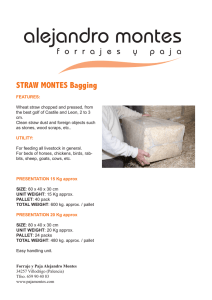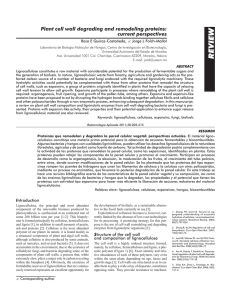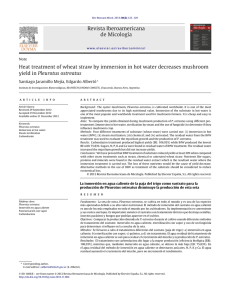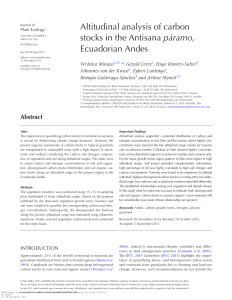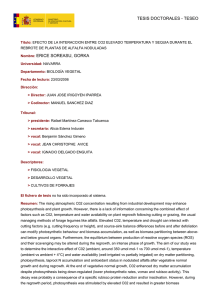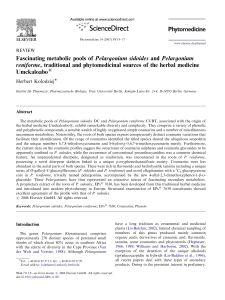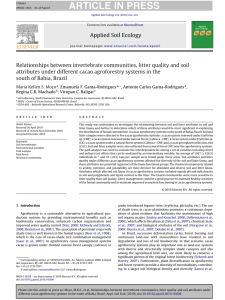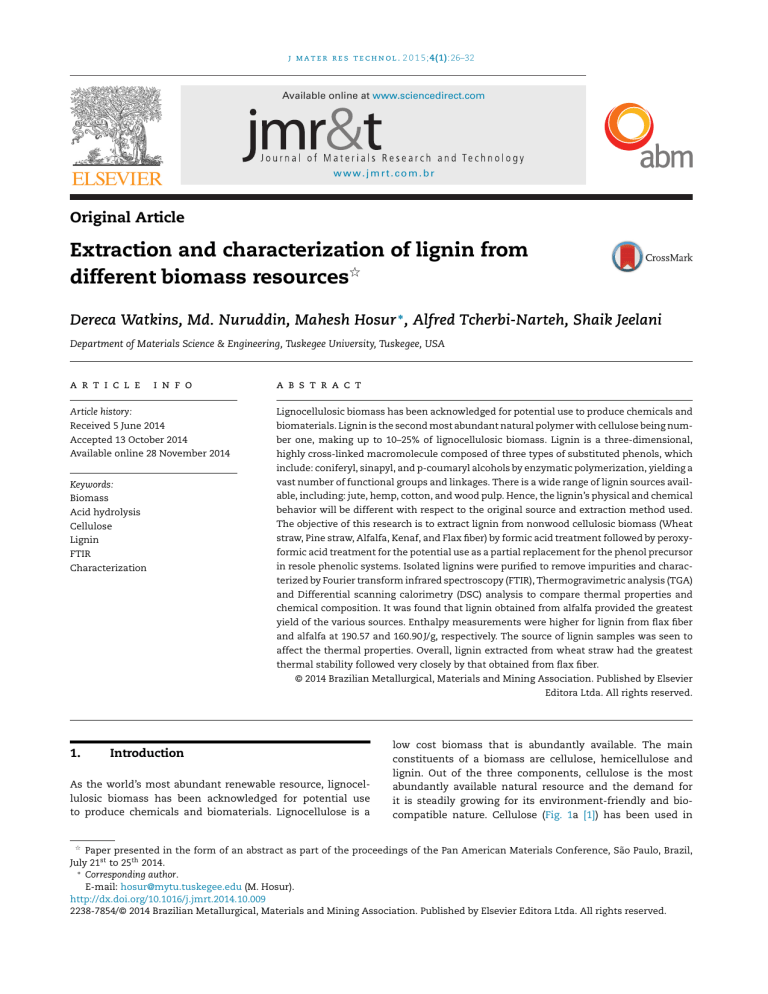
j m a t e r r e s t e c h n o l . 2 0 1 5;4(1):26–32 Available online at www.sciencedirect.com www.jmrt.com.br Original Article Extraction and characterization of lignin from different biomass resources夽 Dereca Watkins, Md. Nuruddin, Mahesh Hosur ∗ , Alfred Tcherbi-Narteh, Shaik Jeelani Department of Materials Science & Engineering, Tuskegee University, Tuskegee, USA a r t i c l e i n f o a b s t r a c t Article history: Lignocellulosic biomass has been acknowledged for potential use to produce chemicals and Received 5 June 2014 biomaterials. Lignin is the second most abundant natural polymer with cellulose being num- Accepted 13 October 2014 ber one, making up to 10–25% of lignocellulosic biomass. Lignin is a three-dimensional, Available online 28 November 2014 highly cross-linked macromolecule composed of three types of substituted phenols, which include: coniferyl, sinapyl, and p-coumaryl alcohols by enzymatic polymerization, yielding a Keywords: vast number of functional groups and linkages. There is a wide range of lignin sources avail- Biomass able, including: jute, hemp, cotton, and wood pulp. Hence, the lignin’s physical and chemical Acid hydrolysis behavior will be different with respect to the original source and extraction method used. Cellulose The objective of this research is to extract lignin from nonwood cellulosic biomass (Wheat Lignin straw, Pine straw, Alfalfa, Kenaf, and Flax fiber) by formic acid treatment followed by peroxy- FTIR formic acid treatment for the potential use as a partial replacement for the phenol precursor Characterization in resole phenolic systems. Isolated lignins were purified to remove impurities and characterized by Fourier transform infrared spectroscopy (FTIR), Thermogravimetric analysis (TGA) and Differential scanning calorimetry (DSC) analysis to compare thermal properties and chemical composition. It was found that lignin obtained from alfalfa provided the greatest yield of the various sources. Enthalpy measurements were higher for lignin from flax fiber and alfalfa at 190.57 and 160.90 J/g, respectively. The source of lignin samples was seen to affect the thermal properties. Overall, lignin extracted from wheat straw had the greatest thermal stability followed very closely by that obtained from flax fiber. © 2014 Brazilian Metallurgical, Materials and Mining Association. Published by Elsevier Editora Ltda. All rights reserved. 1. Introduction As the world’s most abundant renewable resource, lignocellulosic biomass has been acknowledged for potential use to produce chemicals and biomaterials. Lignocellulose is a low cost biomass that is abundantly available. The main constituents of a biomass are cellulose, hemicellulose and lignin. Out of the three components, cellulose is the most abundantly available natural resource and the demand for it is steadily growing for its environment-friendly and biocompatible nature. Cellulose (Fig. 1a [1]) has been used in 夽 Paper presented in the form of an abstract as part of the proceedings of the Pan American Materials Conference, São Paulo, Brazil, July 21st to 25th 2014. ∗ Corresponding author. E-mail: hosur@mytu.tuskegee.edu (M. Hosur). http://dx.doi.org/10.1016/j.jmrt.2014.10.009 2238-7854/© 2014 Brazilian Metallurgical, Materials and Mining Association. Published by Elsevier Editora Ltda. All rights reserved. 27 j m a t e r r e s t e c h n o l . 2 0 1 5;4(1):26–32 CH2OH A CH2OH CH2OH O O H C O H C H C H H H C C O C OH H OH H C O C OH H C O C C H C C C H C H OH H H OH H OH H2COH H2COH B HC O CHO HC H2COH CO CH2 HC CH H2COH CH CH CH CO H3CO O H2COH H2COH H CO 3 H2COH OCH3 HC O CH O HC CHO H2COH H2COH H CO 3 CH H2COH CH O OH O HOCH2 CH CH HOCH2 H2COH CH2OH C O CH CH CHO CO O H2COH OCH3 OCH3 OCH3 CH HC CH OH CH2 HC O H3CO OCH3 O H3CO O H3CO CH HC OCH3 O CH O CO H2C OCH2 O OCH3 HC H3CO CH O H3CO OCH3 O OCH3 H3CO O CH O CO H3CO O OCH3 HC OCH HC CH CH2OH H3CO CH OCH3 O HC OCH3 O OCH3 HCOH O OH H2COH O OCH3 O OCH3 OCH3 HC OCH3 H2COH HC HC H3CO CH OCH3 H3CO OCH3 HC H2COH HC HC HC Lignin HOCH2 CH CHO OCH3 OH C CH2OH CH2OH CH2OH OMe = OCH3 methoxyl group OMe OH P-coumaryl alcohol MeO OMe OH OH Coniferyl alcohol Sinapyl alcohol Fig. 1 – (a) Schematic representation of the cellulose structure [1] (b) lignin structure [2], and (c) structural units of lignin [2]. 28 j m a t e r r e s t e c h n o l . 2 0 1 5;4(1):26–32 various forms ranging from wood and plant fibers to act as a source of energy for applications in building materials, paper, textiles, as well as clothing today [2]. Another growing application of cellulose is in composite materials as reinforcement in polymeric materials. Still, the disadvantages that come with using cellulose are the incompatible nature of the material with hydrophobic polymers, the aggregation of cellulose during processing, and the high water absorption properties. These characteristics can significantly reduce overall properties of cellulose which can also be a direct result of the extraction technique and plants used for the extractions [2]. Lignin, making up to 10–25% of lignocellulosic biomass, is the second most abundant natural polymer [3–5]. Lignin is insoluble in water and stable in nature and acts as the “glue” that connects cellulose and hemi-cellulose. Lignin (Fig. 1b) is a three-dimensional, highly cross-linked macromolecule composed of three types of substituted phenols which include: coniferyl, sinapyl, and p-coumaryl alcohols (Fig. 1c) by enzymatic polymerization yielding a vast number of functional groups and linkages [6–8]. As a natural and renewable raw material, obtainable at an affordable cost, and great chemical and physical properties, lignin’s substitution potential extends to any product currently sourced from petrochemical substances. The areas in which lignin is applicable include: emulsifiers, dyes, synthetic floorings, sequestering, binding, thermosets, dispersal agents, paints and fuels to treatments for roadways [9,10]. There is a wide range of cellulose and lignin sources available including: jute, hemp, cotton and wood pulp. Hence, their physical and chemical behavior will be different with respect to the original source and extraction method used. Therefore, their use in many applications may vary based on formulations. For instance, lignosulfonates, with respect to the sulfite pulping process is one of the traditional forms of lignin that has been used for the high sulfonic acid functional groups which gives them great binding and emulsifying properties. Although numerous studies have been reported in literature about extraction of lignin, in the current work lignin was extracted from pine straw, wheat straw, alfalfa, and flax fiber via organosolv treatment. The resulting organosolv lignin’s thermal properties and functional groups were studied. 2. Materials and methods 2.1. Materials Natural biomass resources were collected from local fields near Tuskegee, AL, USA. Various chemicals used for extraction of lignin like formic acid, acetic acid, hydrogen peroxide, sodium hydroxide and distilled water were obtained from Sigma–Aldrich Inc., USA. 2.2. Experimental procedures 2.2.1. Formic acid/acetic acid treatment Process of lignin extraction from different biomass began first by pulping, where the biomass was cut into small size and placed in a conical flask. A mixture of 85% organic acid (ratio of formic acid/acetic acid mixture was 70:30 by volume) was added to the biomass in the flask at a fiber to liquor ratio of 1:8 and allowed to boil on a hot plate for 2 h. After 2 h, flask and its content was allowed to cool to ambient temperature. Fibers were filtered in a Buchner funnel and washed with 80% formic acid followed by hot distilled water. 2.2.2. Peroxyformic acid/peroxyacetic acid (PFA/PAA) treatment After pulping, FA/AA treated pulps were further delignified by treating them with a mixture of PFA/PAA solution in hot water bath at 80 ◦ C for 2 h. PFA/PAA solution mixture was prepared by adding 8 ml 35% H2 O2 with 85% formic acid/acetic acid mixture. Finally, the delignified fibers were filtered to separate cooking liquor (lignin and hemicellulose mixed with formic acid) from cellulose and washed with hot water. 2.2.3. Bleaching Delignified fibers were subjected to bleaching by treating with 14 ml 35% H2 O2 solution (pH 11–12) in hot water bath at 8 ◦ C for 2 h. Finally, the pulp was washed with distilled water to remove residual lignin. This process was repeated again to remove lignin completely. 2.2.4. Isolation of lignin Lignin was isolated by following the procedure suggested by Nuruddin, et al. shown in Fig. 2 [10]. The spent liquor was heated at 105 ◦ C after pulping and delignification process. The lignin dissolved in formic acid was precipitated by adding distilled water (5 times more than volume of concentrated liquor) and the precipitate was filtered in a Buchner funnel. Finally, the precipitated lignin was washed with distilled water and vacuum dried over P2 O5 . 2.3. Characterization Structural and thermal characterization of lignin was carried out through Fourier transform infrared spectroscopy (FT-IR), differential scanning calorimetry (DSC) and thermogravimetric analysis (TGA). FT-IR measurements of extracted lignin samples were taken using Shimadzu FTIR 8400s equipped with MIRacleTM ATR. Each scan recorded 50 scans, in the range from 500 to 4000 cm−1 with a resolution of 4 cm−1 . DSC measurements of lignin extracted from alfalfa, flax fiber, wheat straw and pine straw were performed using Q2000 from TA Instruments Inc. Approximately 5.0 ± 0.25 mg samples were placed in a hermetic pan and sealed. DSC scans were performed at a heating rate of 5 ◦ C/min from 30 to 400 ◦ C under nitrogen environment. Thermo-gravimetric analysis (TGA) was used to determine the thermal stability, decomposition temperature and char yield for each lignin extracted from different sources. TGA measurements were taken using TA Instruments Q500 setup operating in nitrogen environment. Samples for each measurement were maintained at 14.0 ± 5 mg, and scans were performed from 30 to 800 ◦ C at 10 ◦ C/min to observe thermal degradation and stability of each lignin based on its sources. 29 j m a t e r r e s t e c h n o l . 2 0 1 5;4(1):26–32 Wheat straw Flax fiber Pulp Pine straw Cellulose Delignified fiber Alfalfa fiber Solid residue Concentrated liquor Lignin Fig. 2 – Schematic diagram of the process of lignin extraction. 3. Results and discussion 3.1. Organic acid fractionation of lignin from different biomass resources Extraction of lignin from different bio sources used in this study was carried out using a mixture of formic acid/acetic acid/water for pulping with the main objective of degrading the lignin molecules by dissolving them in the solution and consequently retrieving by washing them. Organosolv (acetic acid/formic acid) under acidic condition cleaves ether bonds between lignin and hemicellulose, thereby accelerating the delignification process [11]. Xu et al. studied the effect of formic acid on delignification and concluded that the obtained pulp after formic acid treatment still contains some lignin, hemicellulose and ash [12]. They further concluded that the presence of H2 O2 in organic acid solution enhanced the delignification process due to the combined effect of formic acid/acetic acid as solvent and peroxyacid as an oxidizing agent to dissolve the lignin in formic acid/acetic acid/hydrogen peroxide media [13]. This action can be explained by the action of hydroxonium ion OH+ formed during the extraction stage of peroxy acids in acidic medium [14–16]. The produced OH+ ion is a strong electrophilic agent which reacts with lignin during the delignification process [17]. To enhance fiber brightness, reduce chlorinated organic matter and the effluent odor, Organosolv treated fibers were bleached with a solution of hydrogen peroxide, a chlorine free bleaching agent. Using of additional H2 O2 in an alkali medium accelerates extraction process. It also acts as a primary delignification and bleaching agent to increase the brightness of the fiber [18]. In an alkaline condition, hydrogen peroxide dissociates to form perhydroxyl anion (HOO− ), which is a strong nucleophilic agent as shown in equation (1). H2 O2 + OH− ↔ H2 O + HOO− (PKa = 11.6) (1) During the delignification process, quinines are formed through the reaction between peroxyacids and perhydroxyl anion. As a result, chromophoric groups responsible for imparting color in the pulp are eliminated [19]. For maximum alkaline peroxide bleaching effect, the temperature must be maintained between 80 and 100 ◦ C leading to higher fiber brightness with minimal pulp degradation [20]. Percent yield of lignin from different natural sources after FA/AA and PFA/PAA acid treatment was determined gravimetrically and the results are presented in Table 1. The results indicate that alfalfa fibers yielded the highest lignin content of 34% followed by pine straw, wheat straw and flax fibers with lignin content of 22.65%, 20.40%, and 14.88%, respectively. Lam et al. reported that the formic acid treatment at atmospheric pressure dissolved 90% of the lignin present in rice straw, which is assumed to have occurred for all extractions in the current study, in order to obtain optimum lignin yields for all natural biomass sources [21]. Table 1 – Organic acid/hydrogen peroxide fractionation of different biomass resources. Lignin source Lignin yield (%) Alfalfa Pine straw Wheat straw Flax fiber 34.00 22.65 20.40 14.88 30 j m a t e r r e s t e c h n o l . 2 0 1 5;4(1):26–32 150 Lignin from Flax fiber Lignin from Wheat straw Lignin from Pine straw Lignin from Alfalfa 100 0 Heat flow (W/g) % Transmittance Lignin-Flax fiber Lignin-Wheat straw Lignin-Alfalfa Lignin-Pine straw 50 –0.2 –0.4 0 4000 3500 3000 2500 2000 1500 1000 500 50 100 Wavenumber (cm–1) Fig. 3 – FT-IR spectra of organosolv lignin extracted from wheat straw, flax fiber, pine straw, and alfalfa. 3.2. Fig. 4 – DSC heat of reaction thermographs of lignin from flax fiber, alfalfa, pine straw, and wheat straw obtained at 5 ◦ C/min. Fourier transform infrared spectroscopy (FT-IR) Organosolv lignin samples extracted from pine straw, wheat straw, flax fiber, and alfalfa fiber chemical structures were analyzed using FT-IR, which showed formate ester and unconjugated carbonyl stretching absorption in 1700 cm−1 range, as can be seen in Fig. 3 in all lignin samples. Specifically, the bands at 1716 cm−1 and 1711 cm−1 are attributed to the esterification of the phenol and alcohol of the propane chain (C␣ and C␥ ), which occurs during the pulping process using formic acid and carbonyl content, respectively. Bands occurring from 1600 and 1500 cm−1 are characteristics of aromatic compounds (phenolic hydroxyl groups) and are attributed to aromatic skeleton vibrations. The bands at 1300 cm−1 (syringyl) and 1200 cm−1 (guaiacyl) indicate presence of both syringyl and guaiacyl in lignin’s chemical structure. These trends have been observed in similar studies on formic acid pulping and bleaching of lignin extracted from dhaincha, kash, and banana stem [15] and fractional characterization of ash-AQ by successive extraction with organic solvents from oil palm EFB fiber [22]. 3.3. 150 Temperature (°C) Differential scanning calorimetry (DSC) Thermal stability studies on lignin extracted from various fibers considered in this study were carried out through DSC where heat of reaction was measured. Enthalpy measurements obtained from DSC was observed to be higher for lignin from flax fiber and alfalfa at 190.57 and 160.90 J/g, respectively as seen in Fig. 4 and Table 2. This suggests that more energy is required to break down the bonds in these lignin compositions yielding a more stable and flame retardant material. 3.4. Thermogravimetric analysis (TGA) Thermal stability and decomposition of organic polymers have been commonly determined using TGA under nitrogen environment. TGA curves reveal the weight loss percentage of materials with respect to the temperature of thermal degradation. In order to determine the best extracted lignin, thermal stability study was conducted on extracted lignin from various sources mentioned in the previous section. Thermal degradation data indicates weight loss and the first derivative (DTG) indicates the corresponding rate of weight loss. The peak of this curve (DTGmax ) can be presented as a measure of thermal decomposition and can be used as a means to compare thermal stability characteristics of different materials. Lignin molecular structure is composed of mostly aromatic rings having various branching, these chemical bonds lead to a wide range of degradation temperature from 100 to 800 ◦ C as expressed by Yang et al. [23]. 30 to 40 wt.% of all lignin samples still remained un-volatized at 800 ◦ C due to the formation of highly condensed aromatic structures which have the ability to form char as seen in Fig. 5 and Table 3. Degradation of the lignin samples can be divided into three stages [24]. In stage one, the initial weight loss step occurred at 30–120 ◦ C due to the evaporation of water absorbed. Stage two is seen to take place around 180–350 ◦ C and is attributed to the degradation of components of carbohydrates in the lignin samples, which Table 2 – Enthalpy of lignin from different biomass resources using DSC. Table 3 – Values of maximum of thermal decomposition temperature (DTGmax ) and unvolatized weight fraction at 800 ◦ C (residue) for all lignin preparation. Lignin source Enthalpy (J/g) Lignin source Alfalfa Wheat straw Pine straw Flax fiber 161.63 157.93 133.07 190.57 ± ± ± ± 1.56 15.16 2.21 8.64 Alfalfa Wheat straw Pine straw Flax fiber DTG (◦ C) 331.87 328.50 336.11 332.44 ± ± ± ± 0.70 8.26 1.61 5.63 Residue (%) at 800 ◦ C 35.04 40.41 29.45 39.22 ± ± ± ± 0.60 1.65 0.94 0.59 j m a t e r r e s t e c h n o l . 2 0 1 5;4(1):26–32 than 500 ◦ C, the process is associated with the decomposition of aromatic rings [22,24,25]. 100 90 Lignin from Wheat straw Lignin from Flax fiber Lignin from Alfalfa Lignin from Pine straw 80 4. Weight loss (%) 70 60 50 40 30 20 10 0 0 100 200 300 400 500 600 700 31 800 Temperature (°C) Fig. 5 – TGA plots of lignin from flax fiber, alfalfa, pine straw, and wheat straw obtained under nitrogen atmosphere at 10 ◦ C/min. are converted to volatile gases such as CO, CO2 , and CH4 . The final stage of degradation occurred over a wide range of temperatures above 350 ◦ C. Within this stage, degraded volatile products derived from lignin including phenolics, alcohols, aldehyde acids along with the formation of gaseous products are getting removed. It can also be observed from the TGA curve that thermal degradation did not commence until the materials had absorbed certain amount of heat energy. Therefore, heat initiated the degradation processes and the breaking down of the structure causing molecular chains to be broken. It can be suggested that the lignin’s thermal properties are dependent on their source. Overall, lignin extracted from wheat straw had the greatest thermal stability and highest char yield of 40.41% followed by flax fiber (39.22%), alfalfa (35.04%), and pine straw (29.45%). DTGmax appeared between 320 and 340 ◦ C for all lignin samples as seen in Fig. 6 and Table 3. In this region, pyrolytic degradation is expected to occur. This degradation process involves fragmentation of inter-unit linkages, releasing of monomers and derivatives of phenol into the vapor phase. Finally, at temperatures greater Conclusions The present investigation includes extraction of lignin from different biomass resources like flax fiber, alfalfa, wheat straw, and pine straw using organosolv treatment which was then characterized through FT-IR, DSC and TGA testing methods. FT-IR spectra showed homogeneity in the chemical structure of extracted lignin samples with treatments of organic solvents. It was found that lignin obtained from alfalfa fiber provided the greatest yield of the various sources. The extracted lignin’s thermal properties were observed using DSC and TGA. DSC was used to observe the heat of reaction of lignin samples. Enthalpy measurements were higher for lignin from flax fiber and alfalfa at 190.57 and 160.90 J/g, respectively. The source of the lignin samples was seen to affect the thermal properties. TGA was used to observe the degradation of biomass. Overall, lignin extracted from wheat straw had the greatest thermal stability and highest char yield of 40.41% followed by flax fiber (39.22%), alfalfa (35.04%), and pine straw (29.45%). The increase in thermal degradation allows char to be formed on the surface which keeps the underling layers from getting burnt. Hence, providing a greater char yield overall proves that the lignin samples have great fire resistant properties which can be attributed to their chemical structure which can provide enhanced thermal properties when they are used as partial replacements in phenolic resin systems. Conflicts of interest The authors declare no conflicts of interest. Acknowledgements The authors are grateful for the financial support of this research from NSF-EPSCoR (EPS 1158862), CREST (EHR 1137681) and IGERT grants (DGE 1144843). references Derivative weight (%/°C) 0.4 Lignin from Wheat straw Lignin from Pine straw Lignin from Flax fiber Lignin from Alfalfa 0.3 0.2 0.1 0 0 100 200 300 400 500 600 700 Temperature (°C) Fig. 6 – Derivative TGA curves of lignin from flax fiber, alfalfa, pine straw, and wheat straw obtained under nitrogen atmosphere at 10 ◦ C/min. 800 [1] My Organic Chemistry [home page on the internet]. Avaialble from: https://myorganicchemistry.wikispaces.com/Cellulose [cited 04.01.14]. [2] Brinchi L, Cotana F, Fortunati E, Kenny JM. Production of nanocrystalline cellulose from lignocellulosic biomass: technology and applications. Carbohydr Polym 2013;94:154–69. [3] Hu L, Pan H, Zhou Y, Zhang M. Methods to improve lignin’s reactivity as a phenol substitute and as replacement for other phenolic compounds: a brief review. BioResources 2011;6(3):3515–25. [4] Min D, Smith SW, Chang H, Jameel H. Influence of isolation condition on structure of milled wood lignin characterized by quantitative 13 ◦ C nuclear magnetic resonance spectroscopy. BioResources 2013;8(2):1790–800. [5] Kuhad R, Singh A. Lignocellulose biotechnology: future prospects. I.K. International Publishing House; 2007. 32 j m a t e r r e s t e c h n o l . 2 0 1 5;4(1):26–32 [6] Lee SH, Doherty TV, Linhardt RJ, Dordick JS. Ionic liquid-meditated selective extraction of lignin from wood leading to enhanced enzymatic cellulose hydrolysis. Biotecnol Bioeng 2009;102(5):1368–76. [7] Brosse N, Ibrahim MNM, Rahim AA. Biomass to bioethanol: initiatives of the future for lignin. ISRN Mater Sci 2011;2011:1–10. [8] Barton F. Chemistry of lignocellulose: methods of analysis. Anim Feed Sci Technol 1988;21:279–86. [9] Wang M, Leitch M, Xu C. Synthesis of phenol–formaldehyde resol resins using organosolv pine lignins. Eur Polym J 2009;45:3380–8. [10] Mankar SS, Chaudhari AR, Soni I. Lignin in phenol–formaldehyde adhesives. Int J Knowl Eng 2012;3(1):116–8. [11] Nuruddin M, Chowdhury A, Haque S, Rahman M, Farhad S, Jahan MS, et al. Extarction and characterization of cellulose microfibrils from agricultural wastes in an integrated biorefinery initiative. Biomaterials 2011;3:5–6. [12] Xu F, Sun J-X, Sun R, Fowler P, Baird MS. Comparative study of organosolv lignins from wheat straw. Ind Crops Prod 2006;23(2):180–93. [13] Li MF, Sun SN, Xu F, Sun RC. Formic acid based organolsolv pulping of bamboo (Phyllostachys acuta): comparative characterization of the dissolved lignins with milled wood lignin. Chem Eng J 2012;179:80–9. [14] Kham L, Le Bigot Y, Delmas M, Avignon G. Delignification of wheat straw using a mixture of carboxylic acids and peroxoacids. Ind Crops Prod 2005;21(1):9–15. [15] Jahan MS, Chowdhury D, Islam MK. Atmospheric formic acid pulping and TCF bleaching of dhaincha (Sesbania aculeata), [16] [17] [18] [19] [20] [21] [22] [23] [24] [25] kash (Saccharum spontaneum) and banana stem (Musa Cavendish). Ind Crops Prod 2007;26(3):324–31. Filippis PD, Scarsella M, Verdone N. Peroxyformic acid formation: a kinetic study. Ind Eng Chem Res 2008;48(3):1372–5. Gierer J. Chemistry of delignification. Wood Sci Technol 1986;20(1):1–33. Shatalov A, Pereira H. Arundo donax L. reed: new perspectives for pulping and bleaching. Part 4. Peroxide bleaching of organosolv pulps. Bioresour Technol 2005;96(8): 865–72. Kham L, Le Bigot Y, Benjelloun-Mlayah B, Delmas M. Bleaching of solvent delignified wheat straw pulp. Appita J 2005;58(2):135–7. Sundara R. Hot peroxide bleaching. Can Chem News 1998;50(1):15–7. Lam HQ, Le Bigot Y, Delmas M. Avignon etG.Formic acid pulping of rice straw. Ind Crops Prod 2001;14(1):65–71. Sun RC, Tomlinson J, Jones GL. Fractional characterization of ash-AQ lignin by successive extraction with organic solvent from oil pam EFB fibre. Polym Degrad Stabil 2000;68:111–9. Yang H, Yan R, Chen H, Lee DH, Zheg C. Characteristics of hemicellulose, cellulose, and lignin pyrolysis. Fuel 2007;86:1781–8. Tejado A, Pena C, Labidi J, Echeverria JM, Mondragon I. Physico-chemical characterization of lignins from different sources for use in phenol–formaldehyde resin synthesis. Bioresour Technol 2007;98:1655–63. El-Saied H, Nada AMA. The thermal behaviour of lignin from wasted black pulping liquors. Polym Degrad Stabil 1993;40:417–21.


